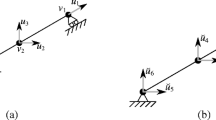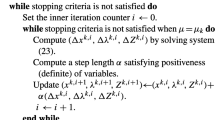Abstract
The robust truss topology optimization against the uncertain static external load can be formulated as mixed-integer semidefinite programming. Although a global optimal solution can be computed with a branch-and-bound method, it is very time-consuming. This paper presents an alternative formulation, semidefinite programming with complementarity constraints, and proposes an efficient heuristic. The proposed method is based upon the concave–convex procedure for difference-of-convex programming. It is shown that the method can often find a practically reasonable truss design within the computational cost of solving some dozen of convex optimization subproblems.
















Similar content being viewed by others
Notes
A truss is an assemblage of straight bars (called members) connected by pin-joints (called nodes) that do not transfer moment. See Sect. 2 for some concrete examples.
The compliance of a truss, formally defined by (16), is equivalent to the twice strain energy of the truss at the equilibrium state under the prescribed boundary conditions (as far as the prescribed displacements are zeros [35]). It can be regarded as a global measure of the displacements, and hence by minimizing the compliance the global stiffness of the truss is maximized.
The ground structure method is commonly used in truss topology optimization. It prepares an initial setting, called the ground structure, consisting of many members connected by nodes. The cross-sectional areas of the members are treated as design variables, while the locations of the nodes are specified. See Sect. 2 for more account.
With reference to concrete examples, we will thoroughly discuss this issue in Sect. 2.
A solution having a chain cannot be in equilibrium with uncertain loads applied at intermediate nodes of the chain. Therefore, the worst-case compliance of the solution is infinitely large.
In this example, overlapping longer members are not incorporated into the ground structure, because with overlapping members the global optimization method (YALMIP [40]) did not converge within realistic computational time.
In fact, \(-\hat{g}_{i}(\cdot \,; \varvec{x}^{(k)})\) is a majorization function of \(-g_{i}\).
Choice of an initial point in the numerical experiments is explained in Sect. 6
The degrees of freedom of a truss are the possible components of the nodal displacements that define the configuration of the truss.
Problem (17) is convex. Various reformulations are known in literature; see, e.g., Achtziger et al. [2] and Jarre et al. [31]. For example, replacing \(\mathop {\mathrm {diag}}\nolimits (\varvec{s})Q\) in (22) with \(\tilde{\varvec{p}}\), one can readily obtain SDP that minimizes w under constraint \( \begin{bmatrix} w&\tilde{\varvec{p}}^{\top } \\ \tilde{\varvec{p}}&K(\varvec{x}) \\ \end{bmatrix} \succeq 0 \), (17b), and (17c). This formulation was used in the numerical experiments. It should be clear that a ground structure with overlapping members is used for generating the initial point, \(\varvec{x}^{(0)}\).
References
Achtziger, W.: Local stability of trusses in the context of topology optimization. Part I: exact modelling. Struct. Optim. 17, 235–246 (1999)
Achtziger, W., Bendsøe, M.P., Ben-Tal, A., Zowe, J.: Equivalent displacement based formulations for maximum strength truss topology design. Impact Comput. Sci. Eng. 4, 315–345 (1992)
Anjos, M.F., Lasserre, J.B. (eds.): Handbook on Semidefinite. Conic and Polynomial Optimization. Springer, New York (2012)
Beck, A., Ben-Tal, A., Tetruashvili, L.: A sequential parametric convex approximation method with applications to nonconvex truss topology design problems. J. Global Optim. 47, 29–51 (2010)
Ben-Tal, A., El Ghaoui, L., Nemirovski, A.: Robust Optimization. Princeton University Press, Princeton (2009)
Ben-Tal, A., Jarre, F., Kočvara, M., Nemirovski, A., Zowe, J.: Optimal design of trusses under a nonconvex global buckling constraint. Optim. Eng. 1, 189–213 (2000)
Ben-Tal, A., Nemirovski, A.: Robust truss topology optimization via semidefinite programming. SIAM J. Optim. 7, 991–1016 (1997)
Bendsøe, M.P., Ben-Tal, A., Zowe, J.: Optimization methods for truss geometry and topology design. Struct. Optim. 7, 141–159 (1994)
Bendsøe, M.P., Sigmund, O.: Topology Optimization. Springer-Verlag, Berlin (2003)
Brittain, K., Silva, M., Tortorelli, D.A.: Minmax topology optimization. Struct. Multidiscip. Optim. 45, 657–668 (2012)
Calafiore, G.C., Dabbene, F.: Optimization under uncertainty with applications to design of truss structures. Struct. Multidiscip. Optim. 35, 189–200 (2008)
Cherkaev, E., Cherkaev, A.: Principal compliance and robust optimal design. J. Elast. 72, 71–98 (2003)
Cherkaev, E., Cherkaev, A.: Minimax optimization problem of structural design. Comput. Struct. 86, 1426–1435 (2008)
Collobert, R., Sinz, F., Weston, J., Bottou, L.: Large scale transductive SVMs. J. Mach. Learn. Res. 7, 1687–1712 (2006)
Dempster, A.P., Laird, N.M., Rubin, D.B.: Maximum likelihood from incomplete data via the EM algorithm. J. R. Stat. Soc. Ser. B (Methodological) 39, 1–38 (1977)
de Gournay, F., Allaire, G., Jouve, F.: Shape and topology optimization of the robust compliance via the level set method. ESAIM Control Optim. Calc. Var. 14, 43–70 (2008)
Figueiredo, M.A.T., Bioucas-Dias, J.M., Nowak, R.D.: Majorization-minimization algorithms for wavelet-based image restoration. IEEE Trans. Image Process. 16, 2980–2991 (2007)
Fung, G., Mangasarian, O.L.: Semi-superyised support vector machines for unlabeled data classification. Optim. Methods Softw. 15, 29–44 (2001)
Gotoh, J., Takeda, A., Tono, K.: DC formulations and algorithms for sparse optimization problems. Math. Program. 169, 141–176 (2018)
Grant, M., Boyd, S.: Graph implementations for nonsmooth convex programs. In: Blondel, V., Boyd, S., Kimura, H. (eds.) Recent Advances in Learning and Control (A Tribute to M. Vidyasager), pp. 95–110. Springer, Vidyasagar (2008)
Grant, M., Boyd, S.: CVX: Matlab Software for Disciplined Convex Programming, Version 2.1 (2016 October). http://cvxr.com/cvx
Guo, X., Bai, W., Zhang, W., Gao, X.: Confidence structural robust design and optimization under stiffness and load uncertainties. Comput. Methods Appl. Mech. Eng. 198, 3378–3399 (2009)
Guo, X., Cheng, G.D., Olhoff, N.: Optimum design of truss topology under buckling constraints. Struct. Multidisc. Optim. 30, 169–180 (2005)
Guo, X., Du, J., Gao, X.: Confidence structural robust optimization by non-linear semidefinite programming-based single-level formulation. Int. J. Numer. Methods Eng. 86, 953–974 (2011)
Hashimoto, D., Kanno, Y.: A semidefinite programming approach to robust truss topology optimization under uncertainty in locations of nodes. Struct. Multidisc. Optim. 51, 439–461 (2015)
Holmberg, E., Thore, C.-J., Klarbring, A.: Worst-case topology optimization of self-weight loaded structures using semi-definite programming. Struct. Multidisc. Optim. 52, 915–928 (2015)
Hunter, D.R., Lange, K.: Quantile regression via an MM algorithm. J. Comput. Graphical Stat. 9, 60–77 (2000)
Hunter, D.R., Lange, K.: A tutorial on MM algorithms. Am. Stat. 58, 30–37 (2004)
Hunter, D.R., Li, R.: Variable selection using MM algorithms. Ann. Stat. 33, 1617–1642 (2005)
Jara-Moroni, F., Pang, J.-S., Wächter, A.: A study of the difference-of-convex approach for solving linear programs with complementarity constraints. Math. Program. 169, 221–254 (2018)
Jarre, F., Kočvara, M., Zowe, J.: Optimal truss design by interior-point methods. SIAM J. Optim. 8, 1084–1107 (1998)
Kanno, Y., Guo, X.: A mixed integer programming for robust truss topology optimization with stress constraints. Int. J. Numer. Methods Eng. 83, 1675–1699 (2010)
Kanno, Y., Takewaki, I.: Sequential semidefinite program for maximum robustness design of structures under load uncertainties. J. Optim. Theory Appl. 130, 265–287 (2006)
Kanno, Y., Yamada, H.: A note on truss topology optimization under self-weight load: mixed-integer second-order cone programming approach. Struct. Multidisc. Optim. 56, 221–226 (2017)
Klarbring, A., Strömberg, N.: A note on the min–max formulation of stiffness optimization including non-zero prescribed displacements. Struct. Multidisc. Optim. 12, 147–149 (2012)
Lange, K., Chi, E.C., Zhou, H.: A brief survey of modern optimization for statisticians. Int. Stat. Rev. 82, 46–70 (2014)
Le Thi, H.A., Pham Dinh, T.: The DC (difference of convex functions) programming and DCA revisited with DC models of real world nonconvex optimization problems. Ann. Oper. Res. 133, 23–46 (2005)
Le Thi, H.A., Pham Dinh, T.: On solving linear complementarity problems by DC programming and DCA. Comput. Optim. Appl. 50, 507–524 (2011)
Lipp, T., Boyd, S.: Variations and extension of the convex–concave procedure. Optim. Eng. 17, 263–287 (2016)
Löfberg, J.: YALMIP: A toolbox for modeling and optimization in MATLAB. In: 2004 IEEE International Conference on Computer Aided Control System Design, Taipei, pp. 284–289 (2004)
Mela, K.: Resolving issues with member buckling in truss topology optimization using a mixed variable approach. Struct. Multidisc. Optim. 50, 1037–1049 (2014)
Mitchell, J.E., Pang, J.-S., Yu, B.: Obtaining tighter relaxations of mathematical programs with complementarity constraints. In: Terlaky, T., Curtis, F.E. (eds.) Modeling and Optimization: Theory and Applications, pp. 1–23. Springer, Berlin (2012)
Muu, L.D., Dinh, Q.T., Le Thi, H.A., Tao, P.D.: A new decomposition algorithm for globally solving mathematical programs with affine equilibrium constraints. Acta Math. Vietnam. 37, 201–217 (2012)
Neumann, J., Schnörr, C., Steidl, G.: Combined SVM-based feature selection and classification. Mach. Learn. 61, 129–150 (2005)
Pham Dinh, T., Le Thi, H.A.: Convex analysis approach to D. C. programming: theory, algorithms and applications. Acta Math. Vietnam. 22, 289–355 (1997)
Pham Dinh, T., Le Thi, H.A.: Recent advances in DC programming and DCA. In: Nguyen, N.T., Le Thi, H.A. (eds.) Transactions on computational intelligence XIII. Springer-Verlag, Berlin (2014)
Pham Dinh, T., Le Thi, H.A.: A D.C. optimization algorithm for solving the trust-region subproblem. SIAM J. Optim. 8, 476–505 (1998)
Pólik, I.: Addendum to the SeDuMi User Guide: Version 1.1. Technical Report. Advanced Optimization Laboratory, McMaster University, Hamilton (2005). http://sedumi.ie.lehigh.edu/
Rozvany, G.I.N.: Difficulties in truss topology optimization with stress, local buckling and system stability constraints. Struct. Optim. 11, 213–217 (1996)
Sriperumbudur, B.K., Lanckriet, G.R.G.: On the convergence of the concave–convex procedure. Adv. Neural Inf. Process. Syst. 22, 1759–1767 (2009)
Sriperumbudur, B.K., Torres, D.A., Lanckriet, G.R.G.: A majorization-minimization approach to the sparse generalized eigenvalue problem. Mach. Learn. 85, 3–39 (2011)
Stavroulakis, G.E., Polyakova, L.N.: Nonsmooth and nonconvex structural analysis algorithms based on difference convex optimization techniques. Struct. Optim. 12, 167–176 (1996)
Sturm, J.F.: Using SeDuMi 1.02, a MATLAB toolbox for optimization over symmetric cones. Optim. Methods Softw. 11(12), 625–653 (1999)
Sun, Y., Babu, P., Palomar, D.P.: Majorization-minimization algorithms in signal processing, communications, and machine learning. IEEE Trans. Signal Process. 65, 794–816 (2017)
Svanberg, K.: The method of moving asymptotes—a new method for structural optimization. Int. J. Numer. Methods Eng. 24, 359–373 (1987)
Svanberg, K.: A class of globally convergent optimization method based on conservative convex separable approximations. SIAM J. Optim. 12, 555–573 (2002)
Takezawa, A., Nii, S., Kitamura, M., Kogiso, N.: Topology optimization for worst load conditions based on the eigenvalue analysis of an aggregated linear system. Comput. Methods Appl. Mech. Eng. 200, 2268–2281 (2011)
Thore, C.-J.: Multiplicity of the maximum eigenvalue in structural optimization problems. Struct. Multidisc. Optim. 53, 961–965 (2016)
Tütüncü, R.H., Toh, K.C., Todd, M.J.: Solving semidefinite-quadratic-linear programs using SDPT3. Math. Program. B95, 189–217 (2003)
Wolkowicz, H., Saigal, R., Vandenberghe, L. (eds.): Handbook on Semidefinite Programming: Theory. Algorithms and Applications. Kluwer Academic Publishers, Boston (2000)
Yonekura, K., Kanno, Y.: Global optimization of robust truss topology via mixed integer semidefinite programming. Optim. Eng. 11, 355–379 (2010)
You, S., Cheny, L., Liu, Y.: Convex–concave procedure for weighted sum-rate maximization in a MIMO interference network. In: 2014 IEEE Global Communications Conference, Austin, pp. 4060–4065 (2014)
Yu, B., Mitchell, J.E., Pang, J.-S.: Solving linear programs with complementarity constraints using branch-and-cut. Technical Report, Department of Mathematical Sciences, Rensselaer Polytechnic Institute, Troy, NY (2016 October)
Yuille, A., Rangarajan, A.: The concave–convex procedure. Neural Comput 15, 915–936 (2003)
Zillober, C.: Global convergence of a nonlinear programming method using convex approximations. Numer. Algorithms 27, 265–289 (2001)
Acknowledgements
This work is partially supported by JSPS KAKENHI 26420545 and 17K06633.
Author information
Authors and Affiliations
Corresponding author
Rights and permissions
About this article
Cite this article
Kanno, Y. Robust truss topology optimization via semidefinite programming with complementarity constraints: a difference-of-convex programming approach. Comput Optim Appl 71, 403–433 (2018). https://doi.org/10.1007/s10589-018-0013-3
Received:
Published:
Issue Date:
DOI: https://doi.org/10.1007/s10589-018-0013-3




